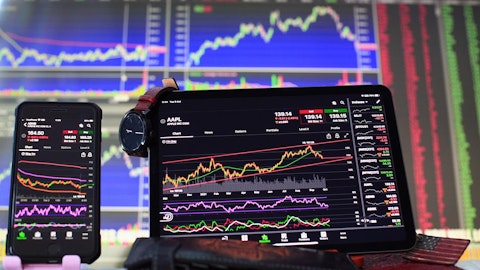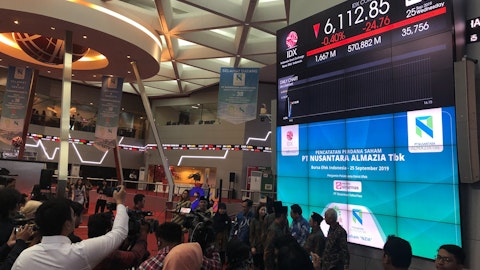Interactive Brokers Group, Inc. (NASDAQ:IBKR) Q4 2023 Earnings Call Transcript January 16, 2024
Interactive Brokers Group, Inc. misses on earnings expectations. Reported EPS is $1.52 EPS, expectations were $1.54. Interactive Brokers Group, Inc. isn’t one of the 30 most popular stocks among hedge funds at the end of the third quarter (see the details here).
Operator: Good day, and thank you for standing by. Welcome to the Interactive Brokers Group Fourth Quarter 2023 Earnings Call. [Operator Instructions] Please be advised that today’s conference is being recorded. I would now like to hand the conference over to your speaker today, Nancy Stuebe, Director of Investor Relations.
Nancy Stuebe: Good afternoon, happy new year, and thank you for joining us for our fourth quarter 2023 earnings call. Thomas is on the call, and asked me to present his comments on the business. Also joining us today are Milan Galik, our CEO, and Paul Brody, our CFO. After prepared remarks, we will have a Q&A. As a reminder, today’s call may include forward-looking statements, which represent the company’s belief regarding future events, which by their nature, are not certain and are outside of the company’s control. Our actual results and financial condition may differ, possibly materially, from what is indicated in these forward-looking statements. We ask that you refer to the disclaimers in our press release. You should also review a description of risk factors contained in our financial reports filed with the SEC.
In 2023, we added over 470,000 net new accounts. Our client equity at year-end was up 39% to $426 billion, an increase of over $100 billion from last year. We earned over $4 billion in net revenues and over $3 billion in pretax income, both for the first time. Our pretax margin was 71% for the full year – by far, the highest in the industry: in fact, very few public companies in any industry have that kind of profit margin. If market conditions continue as they are, even with the three interest rate cuts predicted, I see no reason why we wouldn’t be able to maintain pretax margin at the 70% level. We saw stronger markets in 2023, with the same focus on options and on the Magnificent Seven stock names that we have seen for a year now. We see options being actively traded both traditionally as a means to offset risk, and as standalone zero day to expiry.
Regarding interest rates, we are not willing to argue with the market. If the market believes that long-term rates will be under 4%, we don’t think it’s our business to dispute it. However, there are several long-term trends that, in my opinion, call for higher inflation and higher rates in the long run. First is deglobalization. Over the past few decades, where goods are manufactured has been re- allocated around the globe, often far from consumers as containerization reduced shipping expenses, and manufacturing went where it’s cheapest. Prices of some goods were driven down 50% to 90%. But now, as we have been predicting, geopolitical uncertainty has driven transportation costs up, with insurance for transport rising every day as vessels are attacked and routes become unsafe.
To start producing closer to consumers, where labor is often more expensive, means higher costs and prices. Second is demographics. For the most part, skilled labor is produced in developed countries, like the US and Europe, and to some extent in Asia. Population growth, however, is occurring in those countries where skilled labor is not produced. Birth rates and population growth have dramatically reversed in developed countries to decreasing instead of growing, meaning that skilled labor will cost more and more over time. Third are deficits, deficits contribute to inflation, as interest payments get funded through deficit spending, which then means bigger deficits and higher interest, which gets added onto the deficit, on and on, so it is unclear to me how inflation can substantially decrease as the deficit grows.
Fourth, the ever-increasing demand for spending on environmental projects will continue to become more and more expensive. Combining these factors, it is hard to see how inflation will subside over the long term, even if in the next several months it may ameliorate somewhat. These trends are inescapable, and while you may see long term rates at 4% for now, they could go back to 5%, 6%, 7% or more as costs, deficit spending and the national debt keep increasing. Turning to our business, our client accounts and client equity grew fastest in Europe and Asia as more and more people worldwide want to access international markets, invest in securities they feel offer the most upside regardless of what type of security it is or where it is traded, and hold what they perceive as “safer” currencies.
In 2023, individuals saw the fastest account growth among our five client segments, and the second highest commission and net interest growth. Proprietary traders had the fastest client equity and commission growth. Introducing brokers had the highest net interest growth, followed by individuals and financial advisors – all well over 50%. While we saw growth in hedge fund accounts and significantly higher client equity, they showed a smaller increase in commission and interest activity than our proprietary traders or individuals. This is likely due to so many funds holding the same Magnificent Seven names, but as many of you are on the call maybe you can expand on this. We had one of our busiest years ever of programming. During 2023, we added a wide range of features and capabilities including those for financial advisors; and enhanced IBKR Mobile, Portfolio Analyst, our CRM, and Student Training Lab, plus added comprehensive new content at our Traders Academy, Quant Blog, and Traders Insight.
Our new “Discover” tool lets you see technical insights using actionable analysis and alerts, with a Market Buzz bubble map to identify the companies most in the news, allowing clients to go more in-depth with analytics and sentiment, and has proven quite popular. For our long-short hedge fund and proprietary trading clients, we added features like a Securities Lending dashboard, which gives an expanded universe of securities lending data like borrower and lender depth, among other items. For financial advisors, we are significantly less expensive than competitors. To give an idea of the “value-add” we offer to financial advisors, when an advisor buys a mutual fund for his or her clients at Interactive Brokers, we charge a maximum of $14.95 for the entire trade, and nothing for allocating the mutual fund among any number of clients after the trade.
In contrast, competitors charge $45, per account, to allocate a trade. Our biggest issue is that FAs do not believe us when we tell them they can save thousands of dollars each time they update their customers’ portfolios! For our option traders who do not absolutely need an immediate fill, we built a facility to trade at the mid-price against our marketable order-flow. Option orders in frequently-traded options have a very good chance of being filled within a few minutes. A growing percentage of our options order flow gets successfully executed through this facility. This is in addition to our similar facility for equities, which we have had for some time now and which we continue to build. As we onboard more and more institutional clients, we get more and more liquidity in our ATS, especially for institutions willing to rest orders for a brief period of time.
Ultimately, we believe that the most a broker can do for its customers who trade frequently is to give them the best possible execution prices. This has always been the most important consideration as we have developed our platform over the years. In 2024, we have another active year of programming projects planned, and you will see further upgrades to our platform with more features and capabilities. We are also adding new countries where our clients can trade. I will not say more to avoid tipping off our competitors! Finally, we are well aware that we have now reached $14 billion in equity on our balance sheet. We are considering possible opportunities in the space that would help us grow the business. Our public float is small, so we are unlikely to buy back shares, and personally speaking I would hope that an opportunity presents itself, as raising the dividend is not something I think helps a company grow in the long run.
There is much to look forward to. The Interactive Brokers platform is built with the purpose of bringing investors and marketplaces together to interact with each other, all over the world, optimizing the allocation of capital and resources. It is our job to educate current and beginning investors, to develop the best tools and capabilities to facilitate their investing journey. We are as busy programming as we’ve ever been. This, and our much lower cost structure, is what sets us apart, and will continue to do so in the years ahead. With that, I will turn the call over to Paul Brody. Paul?
Paul Brody: Thank you, Nancy. Good afternoon, everybody and thanks for joining the call. I’ll review the fourth quarter results, and then we’ll open it up for questions. Starting with our Revenue items on page 3 of the release, we are pleased with our financial results this quarter, roughly matching the record adjusted net revenues and pretax income of the prior quarter. And for the full year 2023, we achieved record results in every major financial measure. Commissions rose versus last year’s fourth quarter, reaching $348 million. For the full year, commissions were $1.4 billion, up 3% from 2022. In 2023, we saw higher trading volumes in options and futures, coming from our large base of sophisticated and active traders, investors and advisors.

Net interest income of $730 million for the quarter, and a record $2.8 billion for the year, reflected a risk-on environment that led to steadily higher margin lending as well as higher yields on our margin loans and segregated cash portfolio. This was partially offset by the higher interest paid to our customers on their cash balances, as Interactive Brokers passes through to them all rate hikes above the first 50 basis points on their qualified funds, which differentiates us in an environment where many competitors pay little to nothing to their customers. Other fees and services generated $55 million for the quarter and $197 million for the year. The increase from the prior year quarter was driven by the risk-on positioning of customers, which led to a rise in risk exposure fees to $17 million, as well as higher FDIC sweeps fees, which rose to $6 million this quarter.
Market data fees of $17 million and exchange liquidity payments of $8 million were the other factors in this category. Other income includes gains and losses on our investments, our currency diversification strategy, and principal transactions. Note that many of these non-core items are excluded in our adjusted earnings. Without these excluded items, other income was $16 million for both the quarter and the full year. Turning to expenses, Execution, Clearing and Distribution costs were $100 million in the quarter, and $386 million for the year, up versus last year primarily due to higher volumes in options and futures, which carry higher fees. As a percent of commission revenues, Execution & Clearing costs were 23% in the fourth quarter for a Gross Transactional Profit margin of 77%, unchanged from last quarter.
We calculate this by excluding from “Execution & Clearing” $20 million of costs, predominantly market data, without a direct commission revenue component. Compensation & Benefits expense was $136 million for the quarter, for a ratio of Compensation expense to Adjusted Net Revenues of 12%, unchanged from last year. For the year, this ratio was also 12%, down from 14% in 2022. We are always focused on expense discipline while improving our strong top line. Our headcount at year-end was 2,932. G&A expenses were $45 million, down from the year-ago quarter. For the full year, recall that 2023’s number is inflated due to a previously-disclosed regulatory settlement in the second quarter. Without that, full year G&A would have been even with 2022.
Our pretax margin was 72% for the quarter and 71% for the year. Automation and expense control, along with thoughtful management of our balance sheet, remain our key means of maintaining high margins, while we invest in the future of our business. Income Taxes of $77 million reflects the sum of the public company’s $45 million and the operating companies’ $32 million. The public company’s taxes included a decrease in the deferred tax asset, which reflects an annual remeasurement of future tax benefits. Together with some other items, these had an $8 million impact on income taxes. Removing these one-time non-cash items, the public company’s adjusted effective tax rate was 17.9%, within its usual range. For the year, taxes of $257 million are the sum of the public company’s $142 million and the operating companies’ $115 million.
Moving to our balance sheet on page 5 of the Release, our total assets ended the year 12% higher at $128 billion, with growth driven by higher customer cash and margin loan balances from both new and existing customers. We maintain a balance sheet geared towards supporting our growing business and providing sufficient financial resources during volatile markets. We have no long-term debt. Our ample capital base is deployed primarily in running our current business and our liquidity positions us to support our customers during periods of high market stress. It also helps us win new business, by showing the strength and depth of our balance sheet to current and prospective clients and partners. In our operating data, on pages 6 and 7, our contract volumes in options for all customers rose 21% over the prior-year quarter, well above industry growth.
Futures contract volumes rose 4%, while stock share volume declined for us as it did across the industry. For the full year, options and futures contract volumes rose 12% and 1%, respectively. The decrease in stock share volume was largely attributable to lower trading in pink sheet and other very low-priced stocks. The notional value of brokerage shares traded, however, was up in most markets, particularly in the US, as clients gravitated to larger, higher quality names. On page 7, you can see that total Customer DARTs were 1.9 million trades per day, up 2% from the prior year and reflecting a more risk-on period for investors. Commission per Cleared Commissionable Order of $3.19 was up slightly from last year, driven by increases in futures volume and average trade size.
Options contributed higher volume but a lower average trade size, and stock trade volume and average trade size both declined. Page 8 shows our Net Interest Margin numbers. Total GAAP net interest income was $730 million for the quarter, up 29%, and $2.8 billion for the year, up 68%. Our net interest income as displayed in our NIM, was $9 million higher, or $739 million, as we include income here that for GAAP purposes is classified as other fees or other income, but that we feel is more appropriately considered interest. These results reflect strength in margin loan and segregated cash interest, partially offset by higher interest expense on customer cash balances. Most central banks around the world, including the Federal Reserve, held interest rates steady this quarter, with only Australia increasing its benchmark rate slightly.
The Federal Reserve raised interest rates four times over the year, raising the average US Fed funds rate for the fourth quarter to 5.33% from 3.65% the prior year. Our segregated cash interest income rose 67% on a 4% increase in average balances, while margin loan interest rose by 50% on a 9% increase in average balances. The average duration of our portfolio remained at under 30 days. With the US dollar yield curve inverting further over the fourth quarter, we have been maximizing what we earn by capturing higher short-term yields, rather than accept the significantly lower yields of longer maturities. In this rate environment, this strategy allows us to maintain a relatively tight maturity match with the rate we pay our customers. Securities lending net interest has not been as strong as in prior quarters for two main reasons.
First, overall customer demand for shorting stocks has fallen. There were fewer “hard to borrow” names industry-wide which, with the market’s low volatility, are the drivers of securities lending. Second, as we have noted on previous calls, higher average interest rates versus prior periods means more of what we earn from securities lending is classified as interest on “segregated cash”. To more accurately compare our securities lending revenue with the year-ago quarter, we estimate that if the interest earned on this cash collateral fell under “Securities Borrowed and Loaned”, it would have been $18 million higher, or $61 million. Interest on Customer Credit Balances, the interest we pay to our customers on the cash in their accounts, rose on both higher rates in nearly all currencies and higher balances from new account growth.
As we have noted many times in the past, the high interest rates we pay on customer cash – currently 4.83% on qualified US dollar balances – is a significant driver of new customers. Fully rate-sensitive balances were about $18 billion this quarter. Now, for our estimates of the impact of changes in rates. Given market expectations of rate cuts in 2024, we estimate the effect of such changes in the Fed Funds rate to be a $56 million reduction in annual net interest income for each 25-basis point decrease in the benchmark. Note that our starting point for these estimates is year-end, with the Fed Funds effective rate at 5.33%, and average balances as of December 31st. Any growth in our balance sheet and interest- earning assets would reduce this impact.
About 25% of our customer cash balances is not in US dollars, so estimates of a US rate change exclude those currencies. We estimate the effect of decreases in all the relevant non-USD benchmark rates would further reduce annual net interest income by $18 to $20 million for each 25-basis point decrease in those benchmarks. In conclusion, we had a financially strong quarter to close out a record year in net revenues and pretax margin, reflecting our continued ability to grow our customer base and deliver on our core value proposition to customers while scaling the business. This highlights the attractiveness of our strategy – automating as much of the brokerage business as possible and expanding what we offer while minimizing what we charge.
And with that, we’d like to open it up for questions.
See also Best Malpractice Lawyers in Each of 30 Biggest Cities in the US and 10 Dividend Aristocrats That Slashed Their Dividends.
Q&A Session
Follow Interactive Brokers Group Inc. (NASDAQ:IBKR)
Follow Interactive Brokers Group Inc. (NASDAQ:IBKR)
Operator: [Operator Instructions] Our first question comes from James Yaro with Goldman Sachs.
James Yaro: I’d like to start with your outlook for deploying your excess capital. Maybe you could just speak to how you think about the balance between organic investment and inorganic growth. And then perhaps if you could just speak to the timeline over which you might contemplate that inorganic growth and what sort of businesses you might be looking for?
Milan Galik: So, as you know, we have significant cash reserves, significant amount of capital that we could deploy and would like to deploy. We have been looking for possible acquisition targets. They are all in our industry. They tend to be brokers who are less efficient than we are. We have closely looked at a number of them. We either find the price to be too high for acquisition or find that the acquisition would represent a very significant amount of work in terms of the integration. So, so far we have not found any target that we would actively go after. But we hope that that will change in the future.
James Yaro: Okay. That’s very helpful. Maybe if we could just touch quickly on the prime brokerage and prop trading opportunity. Maybe if you could just speak to where you see– where you are in the growth ramp for prime. And what do you think the business could look like on your platform over the next few years? You have talked about adding new hedge funds, both the small and large. So maybe you could just speak about when you talk to those clients, what attracts the larger hedge funds to your platform?
Milan Galik: Interactive Brokers has been successful in attracting smaller hedge funds. These are typically the hedge funds that the bigger primes declined to do business with because of the higher cost structure that they have. And then what we find is as the hedge funds get bigger, they start to look around and consider these larger competitors of ours. We would obviously like to reverse that trend, but it’s not going to be easy. Part of the problem that we are dealing with is that the large primes are banks that have been in business for 100 years or more and they have created a very significant brand recognition. That is what we are up against. So, we hope that the significant amount of capital that we have on our balance sheet will be attractive for the manager that looks at our large competitors, they will consider us because they will walk away with the belief that their assets are safe with us.
Operator: Our next question comes from Craig Siegenthaler with Bank of America.
Craig Siegenthaler: We wanted your perspective on the potential money in motion in the active trader segment. So, your biggest active trader competitor will be integrating into a larger financial services firm in a few months. And I’m wondering if you think this is an opportunity for IBKR to pick up share in the active trader segment.
Milan Galik: Are we talking about thinkorswim and Schwab?
Craig Siegenthaler: Yes.
Milan Galik: So, to my knowledge, the thinkorswim platform is going to be made available to the active traders on the Schwab platform. So, I would not necessarily see this as an opportunity for the accounts to move from Schwab to Interactive Brokers, but you might have heard something different. I’m not sure.
Craig Siegenthaler: Okay. For my follow-up, can you provide us your outlook for margin loan balances? Are we at a point where you think they can start to grow?
Milan Galik: Well, the margin loan balances are somewhat related to the interest rates, how expensive it is to put the margin positions on. They also depend on the market opportunities that are in the market. So, the higher the volatility, the greater these balances tend to be. As the number of accounts is growing, that should also increase the margin balances. So, I’m optimistic that they will increase over time.
Operator: One moment for questions. Our next question comes from Benjamin Budish with Barclays.
Benjamin Budish: You made the comment earlier in the prepared remarks about the 70% margin for this year, and I think earlier at a public appearance, you talked about sort of high single-digit operating expense growth for the year. Can you maybe talk about what that means for the top line? How do you think about sort of the interplay between lower rates potentially impacting net interest income, maybe this is offset by higher commissions. We’ve seen cash balances come up a little bit. How do you think about those two– sort of the interplay between those two and how that could evolve over the year and perhaps how you think about that a little bit longer term? I know in the past, you’ve sort of commented well, the margin could maybe in the low 60s to high 60s. It sounds like there’s a little bit more confidence on that 70% mark. So just curious of your thoughts there.
Thomas Peterffy: So, I think it’s going to be a race — a dead heat — between lower interest rates, reducing our earnings and higher– more activity increasing our earnings. So that’s how I see it.
Benjamin Budish: Got it. And maybe any– last year, you sort of gave us an early look on the account– expected account growth into ‘23. I understand your position on the introducing brokers at this point, but any thoughts on what to expect this year or sort of 20% the right way to think about it? Any potentially large partners onboarding that might come on at any point?
Milan Galik: Well, I think the best piece of guidance we can give you is that you can look at how we have been growing over time and you can sort of jump to your own conclusions as to how that is going to look. The mix of the business, the various segments of the business that we have — individual clients, introducing brokers, hedge funds, prop trading firms, financial advisers — It’s not obvious to me how that makes you change over time. So, I would expect roughly the same growth numbers for the next year.
Operator: Our next question comes from Brennan Hawken with UBS.
Brennan Hawken: Thomas, you just talked about this sort of briefly, but I’m curious if you drill down into it a little bit in more detail. So— and how we should be thinking about the offsets? And obviously, there’s a $56 million impact for each 25-basis point rate cut. But how do you think about lower rates and how that translates into volumes and commissions and higher cash balances and margin loans? Like how do you anticipate that interplay to actually develop?
Thomas Peterffy: So, I expect rates to be cut by 75 basis points in the course of the year. As you heard, our interest income would come down by $300 million— actually $304 million, if you extrapolate what Paul said putting US dollar deposits and foreign deposits together. So, if we come down by three- quarters that will be $220 million—about $230 million. And I think that— I mean, look— I believe that our earnings increased due to the continuing increasing activity and increasing number of accounts and new accounts being onboarded will outstrip that. But I can’t promise you that, it’s just what I think. So, I do believe that on balance, our earnings in 2024 will be higher than they were in 2023.




